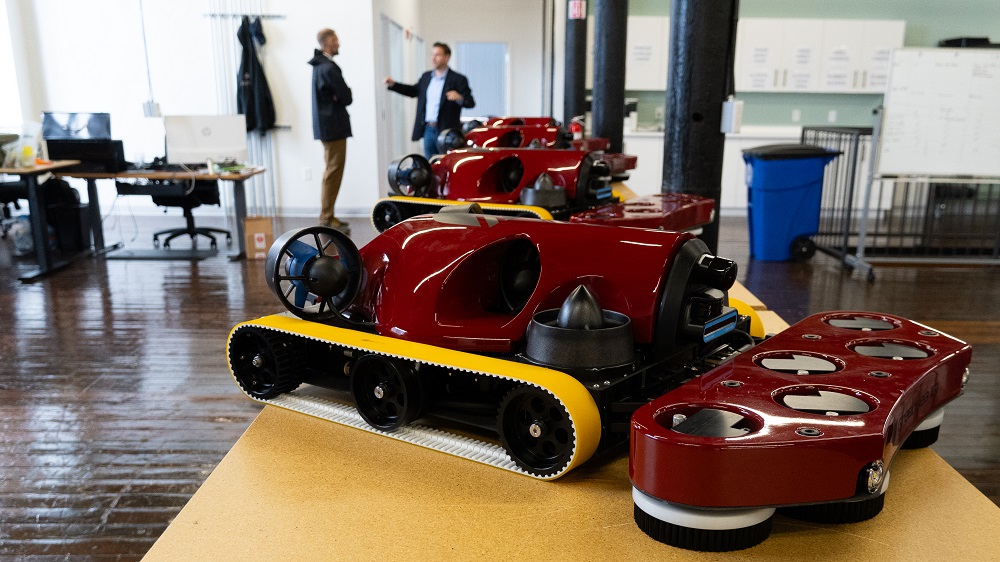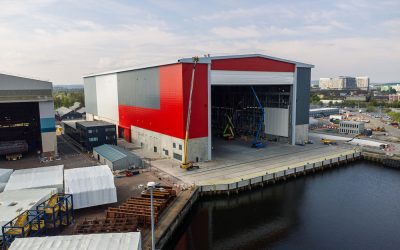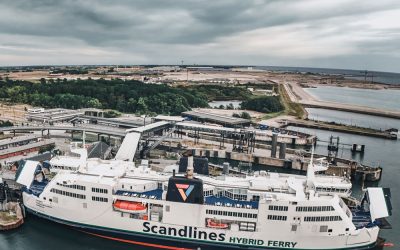New research in hull coatings and grooming could revolutionise vessel efficiency
In maritime operations the importance of marine coatings extends far beyond mere aesthetics. The outside layer of a vessel’s hull serve as the first line of defence against corrosion, fouling, and degradation. Thus, playing a critical role in safeguarding marine assets, optimising vessel efficiency, and minimising environmental impact. Traditional standards for paint approvals by class societies have historically prioritised TBT-free compositions and anti-fouling attributes. However, a significant shift is underway within the marine coating industry, marked by the emergence of enhanced type approvals that emphasise performance-driven criteria.
Traditional coatings have often relied on biocides such as copper based products or tributyltin (TBT), which is now banned, in order to deter marine fouling organisms. However, increasing regulatory scrutiny and environmental concerns have spurred the development of alternative formulations that minimise environmental impact while maintaining efficiency.
One such innovation is the use of self-polishing copolymer (SPC) coatings, which release biocides gradually over time, ensuring long-term anti-fouling performance without the need for frequent recoating. These coatings operate on the principle of controlled leaching, where the release rate of biocides is optimised to provide continuous protection against fouling organisms while minimising environmental contamination.
Another promising avenue is the development of graphene-based hard foul release coatings, such as those developed by Canadian manufacturer GIT Coatings (Graphite Innovation & Technologies Inc.)). The company utilises the low surface energy of graphene-based formulations to prevent fouling organisms from adhering to the hull surface. Unlike traditional anti-fouling coatings, hard foul release coatings do not rely on biocides or silicone oils, making them environmentally friendly and suitable for sensitive marine ecosystems. Additionally, their smooth surface reduces drag, leading to improved fuel efficiency and overall vessel performance.
In recent years, the integration of nanotechnology has further expanded the capabilities of marine coatings. Nanoparticles such as graphene, carbon nanotubes, and nanosilver have been incorporated into coating formulations to enhance strength, durability, and anti-fouling properties. Graphene, in particular, has attracted attention for its exceptional mechanical strength and lubricating properties, making it an ideal candidate for ultra-low friction coatings that reduce drag and improve fuel efficiency.
One notable aspect of this evolution is the redefinition of type approvals to encompass broader parameters beyond mere toxicity and anti-fouling properties. Enhanced type approvals now place a greater emphasis on performance warranties, scrutinising the enduring efficacy of coatings in dynamic marine environments. Dr. Marciel Gaier, CTO at GIT highlights the development of ultra-low friction coatings, which not only enhance vessel efficiency but also demonstrate a commitment to environmental sustainability through the incorporation of materials like graphene. GIT’s coating’s which are designed for a variety of vessel types have also been engineered to be resistant to the heavy-duty wear that comes with the intensive regime of cleaning a vessel’s hull.
“The industry is moving towards more grooming and proactive maintenance of ship hulls. We engineered this paint to be more resistant to grooming so the whole idea is that if you do groom, you don’t damage and or change the paint,” says Dr. Gaier.
The pivotal role of grooming technology in preserving coating integrity and optimising vessel performance shows that both are two sides of the same coin. Ryan Ingham, GIT’s Vessel Performance Manager emphasises that a one-size-fits-all solution is inadequate, necessitating bespoke approaches tailored to each vessel’s specific operational profile.
“Each vessel needs to choose a product type that best fits their operating profile, and then customise a grooming regime for that operating profile with that product type. Some vessels don’t operate well with certain products, so we won’t suggest our products if the owner doesn’t have a proper biofouling management plan in place,” says Ingham.
The company has also designed software to analyse the effects of grooming and maintenance on different coating types, depending on vessel design and operational circumstances. “We are developing performance modelling simulations on a ship specific basis. We are looking at the trade of the vessel, the biofouling risk, the vessel characteristics, and we are trying to model the effect of different coating technologies together with cleaning, either proactive or reactive,” says Philippos Sfiris, Head of Go-to-Market Strategy and Vessel Performance at GIT Coatings. “This is a very important aspect because it’s also something that can help the operator to make the right decision, but this is a very ship specific investigation is needed there,” he adds.
Owners and operators are now no longer solely selecting coatings based on their anti-fouling properties but also must consider their environmental implications. The industry is navigating a diverse array of compositions to strike a balance between efficiency and ecological sustainability. The current efficiency of hybrid silicone coatings and the advantages of hard foul release coatings are being explored in detail, reflecting a growing awareness of environmentally conscious coating solutions. However, even biocide coatings cannot prevent a build up of slime and algae on a vessel’s hull. This is where proactive hull cleaning comes in.
“No coating, no matter what biocide you use can prevent slime, which is a big contributing factor for increased fuel consumption,” says Ingham. “Therefore we recommend proactive grooming because with a perfectly clean hull you can have the best performance and this is reflected in fuel consumption as well. So operators can also compare the amount of additional resistance that is when there is fouling. The more fouling there is, the more increase there will be in terms of drag and fuel consumption. If you can keep your hull free of slime and free of any fouling with grooming, that would be the best performance scenario.”
As a result research from grooming specialists, such as EverClean, a service run by US company GreenSea IQ, underscores a holistic approach towards vessel maintenance. By embracing ship-specific performance modelling and predictive analytics, stakeholders can pre-emptively address coating degradation and optimise vessel efficiency, thus aligning with both economic and environmental imperatives.
EverClean’s proactive hull cleaning approach represents a significant stride in this direction. By advocating for high-frequency cleaning and actively removing fouling organisms before they proliferate using the company’s own design of small tethered robot. This allows the crew to clean the hull without the need for full dry docking or divers.
“We can do it without interfering with operations, such as running concurrently with loading and offloading or while at anchorage when the ship is sitting idle waiting to pull in,” says Karl Lander, Director, Regulatory Compliance & Outreach at GreenSea IQ. “I know we’re seeing a lot of just in time arrivals from operators looking for optimal transit speeds so it’s not perfect but if ships are sitting idle for a day or two before pulling into port it’s a great opportunity for this cleaning to occur,” he adds.
By cleaning more regularly using their robot the team behind EverClean aim to disrupt the biofouling lifecycle while minimising the need for harsh chemicals or coatings. Through with coating manufacturers, they are looking to place themselves at the forefront of developing a non-biocidal and durable alternative to traditional hull cleaning methods.
EverClean also has an aggressive testing regime that allows them work out if their cleaning robot’s bristles will work with different types of hull coatings. “I think we’ve probably done about 20 different coatings now that we’ve tested through varying degrees. One of our main testing processes is what we call our accelerated wear testing, where we submerge test panels down in Florida in a very high growth environment for a couple weeks to get the initial level of fouling on them. This makes sure that we determine our proper cleaning approach,” says Lander.
The evolution of marine coatings reflects a broader shift towards performance-driven and environmentally conscious solutions. As the industry continues to navigate the complexities of coating compositions and grooming practices, collaborative efforts between stakeholders, grooming specialists, and regulatory bodies will play a pivotal role in shaping the maritime landscape of tomorrow. Ultimately, by prioritising efficiency, sustainability, and proactive maintenance, the industry can ensure the longevity and resilience of marine assets while minimising their environmental footprint.
Despite these advancements, challenges remain in ensuring the long-term efficiency and environmental sustainability of marine coatings. Coating degradation due to abrasion, UV exposure, and chemical exposure remains a concern, necessitating ongoing research into novel materials and application techniques. Moreover, the environmental impact of coating leachates and residues requires careful consideration, especially in ecologically sensitive areas.
The proactive approach advocated by companies like GIT and EverClean could become increasingly relevant. By combining advanced coatings with high-frequency cleaning practices, vessel owners can maintain optimal performance while minimizing environmental impact.
The evolution of marine coatings reflects a convergence of technical innovation, environmental stewardship, and regulatory compliance. As the industry continues to adapt to evolving requirements and societal expectations, the development of sustainable, high-performance coatings will likely become more important in years to come.






